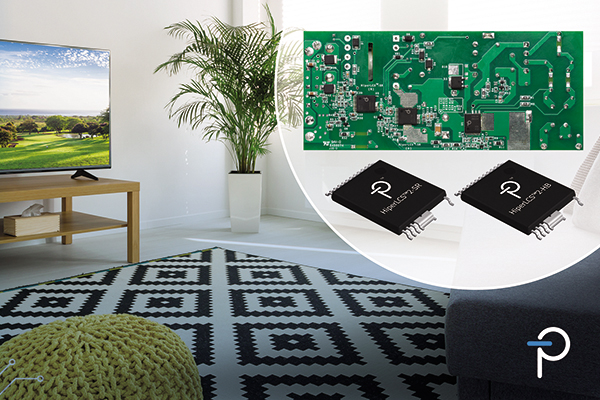Visit any tradeshow with a power semiconductor element and it won’t take you very long to be talking about GaN (gallium-nitride) or SiC (silicon carbide). Wide bandgap (WBG) switches have come a long way since the time when they were considered ‘exotic’ solutions. They were reserved only for RF and microwave or LED applications. These devices are now becoming ubiquitous, for very good reasons – in many applications they significantly out-perform traditional devices. But it is easy to get caught up in the hype. This is especially true if suppliers specialize exclusively on one WBG technology rather than adopting the most appropriate technology for an application.
Misconceptions:
For many years, the main champions of WBG devices, especially GaN, were small start-ups. This led to a few misconceptions: WBG switches are difficult to drive; GaN and SiC FETs are expensive. Further, availability of parts is limited. However, in the last five years, many of the major power semiconductor players have entered the market. Either with their own parts or in partnership with another supplier. This has led to a wider acceptance of GaN and SiC as established technologies that any competent engineer can work with, rather than being the preserve of a WBG expert.
However, many companies – large and small – still clearly align themselves with one or other technology: ‘GaN is good for everything’; ‘SiC is the clear winner’. Power Integrations takes a different view. The company fully embraces the use of a variety of WBG semiconductor technologies. The proof points are first, that Power Integrations supplies the most GaN switches (according to industry analysts, Yole Développement). Second, that the company recently introduced a unique SiC-based solution to address the EV market. Third, that Power Integrations adopts 650, 725 and 900 V silicon switches in devices where they are best suited. Power Integrations, therefore, is employing GaN and SiC alongside more conventional switches, often within the same family of products. This is to capture the tremendous advantages of power density, robustness and efficiency that each offers.
The company’s position on WBG semiconductors is that, while they are very exciting and enabling, they are only part of the overall IC solution. This also includes innovative products using traditional silicon.
Power Integration:
At Power Integrations, we like to describe our approach as technology-agnostic. We simply choose the technology – GaN, SiC or Si – that best suits the application. This is why Power Integrations has never trumpeted our leadership in, say, GaN. We want to provide engineers with solutions that enable them to design, for example, the highest-power-density fast charger. We don’t want them to have to learn all about how to drive or protect a new semiconductor technology.
Equally, because our IC solutions do much more than just switch (which is the function of the GaN or SiC element within the IC package), we do not advertise them, for example, as ‘GaN devices’ or ‘SiC devices’. Instead, they are ‘high-efficiency flyback converters’ or ‘the industry’s most integrated, automotive qualified, 1700 V rated switching power supply solution’. And when we believe that GaN or SiC will not provide any significant benefit, we’ll employ our expertise in silicon technologies to develop leading performance LLC ICs based on FREDFETs (fast-recovery epitaxial diode FETs) or ultra-low Qrr diodes using merged PiN and Schottky technology.
InnoSwitch IC:
Let’s take our InnoSwitch IC family as an example. Power Integrations launched the first InnoSwitch flyback power supply IC solutions using silicon switches with a range of voltage levels back in 2014. The key innovation was not the switch, it was Power Integrations’ unique FluxLink technology. It enables high-performance, secondary-side control to be delivered with the simplicity and low component count usually associated with primary-side regulation. This allows highly efficient synchronous rectification technology to be employed. Thus, resulting in extremely efficient performance across the full load range with very low no-load consumption. Devices easily meet all global energy-efficiency regulations and improve reliability since they make optocouplers redundant.
Today, InnoSwitch is a flyback power supply IC platform. Many devices still use silicon switches, but others use GaN or SiC options. The drivers, controllers, protection and packaging are designed to accommodate all switch types. For example, all use the isolated FluxLink high-speed magneto-inductive communications link. InnoSwitch devices powered by Power Integrations’ PowiGaN gallium-nitride switches include InnoSwitch3-PD (Figure 1). It is an off-line quasi-resonant flyback switcher IC that integrates USB Type-C and USB PD controller, up to 750 V GaN switch, synchronous rectification and FluxLink feedback control. Another GaN part in the InnoSwitch family is the InnoSwitch4-CZ. When used in conjunction with the ClampZero active clamp IC (also GaN-powered), results in the smallest commercially-deliverable 110 W USB smart mobile device charger.

InnoSwitch3-AQ:
Maintaining its technology agnosticism, Power Integrations recently introduced a new automotive InnoSwitch IC, the AEC-Q100 qualified InnoSwitch3-AQ. It uses a SiC primary switching MOSFET to achieve 1700 V rating. Devices still retain the FluxLink feedback link, providing reinforced isolation at 5000 VRMS for secondary-side control, accurate regulation, and extremely fast transient response. Synchronous rectification and a quasi-resonant flyback controller deliver greater than 90 percent efficiency. The circuit will work down to 30 volts without external circuitry – which is a critical requirement for automotive functional safety. This provides additional design margin compared to conventional solutions, which struggle to maintain output below 50 V. Additional protection features include input undervoltage, output overvoltage and overcurrent limiting.
HiperPFS-5:
Another new GaN part is the HiperPFS-5 family of power-factor-correction (PFC) ICs with an integrated 750 V PowiGaN switch. With efficiency of up to 98.3 percent, the new ICs deliver up to 240 W without a heatsink and can achieve a power factor of better than 0.98. HiperPFS-5 ICs target high-power USB PD adapters, TVs, game consoles, all-in-one computers, and appliances. They can be used in conjunction with the company’s InnoSwitch flyback IC family, but, intriguingly, for the ultimate in efficiency, they can also be coupled with another new silicon-based power supply IC from Power Integrations.
The new HiperLCS-2 chipset uses FluxLink and Power Integrations’ unique 600 V FREDFETs with lossless current sensing and high- and low-side drivers to simplify the design and manufacture of LLC resonant power converters. This highly integrated, energy-efficient architecture eliminates heatsinks and reduces component count by up to 40 percent compared to discrete designs. GaN was not chosen for this application because low RDS(ON), a key benefit of GaN, is not especially beneficial in the circuit design that uses high-voltage, low-current energy transfer.
WBG solution:
As another example of a silicon technology being preferred to a WBG solution, Power Integrations also offers the merged pin and Schottky ultra-low Qrr Qspeed diodes which benefit parallel protection circuit designs in automotive applications.
Be under no illusion, Power Integrations is fully committed to WBG solutions: witness the huge investment the company has made in developing its own PowiGaN technology and entering the EV market with SiC-enabled parts. But following one or more technologies blindly will inevitably lead to technical compromises. Power Integrations has leading efficiency performance as its mantra; therefore, we believe it is more beneficial to focus on solutions rather than technologies.
For more information, please visit www.power.com.
About the author:
Mike Matthews is the Vice President of Product Development at Power Integrations.















